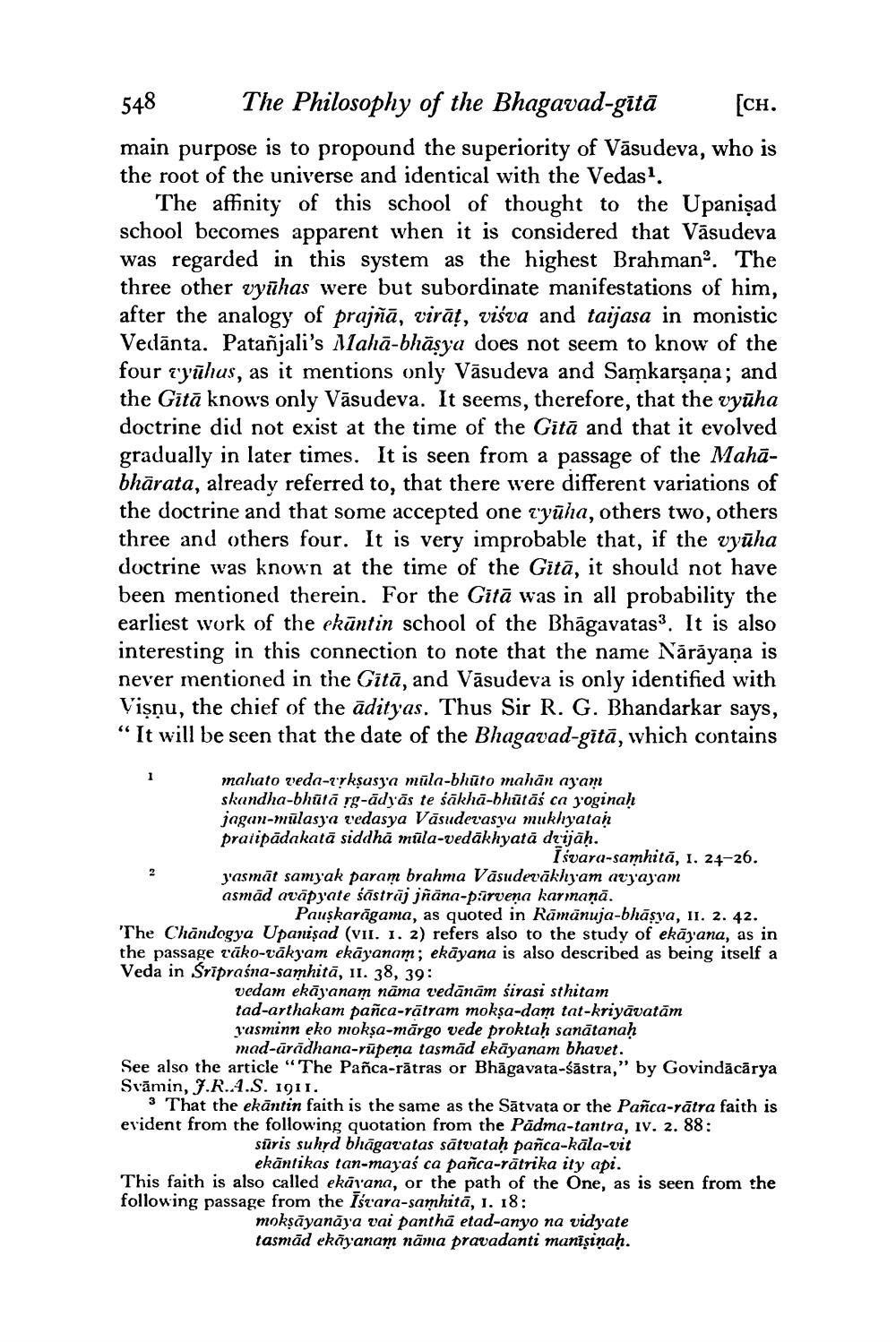________________
548 The Philosophy of the Bhagavad-gitā [ch. main purpose is to propound the superiority of Vāsudeva, who is the root of the universe and identical with the Vedas.
The affinity of this school of thought to the Upanişad school becomes apparent when it is considered that Vasudeva was regarded in this system as the highest Brahman'. The three other vyūhas were but subordinate manifestations of him, after the analogy of prajñā, virāț, viśva and taijasa in monistic Vedānta. Patañjali's Alahā-bhāsya does not seem to know of the four tyūhus, as it mentions only Vāsudeva and Samkarşaņa; and the Gītā knows only Vāsudeva. It seems, therefore, that the vyūha doctrine did not exist at the time of the Gitā and that it evolved gradually in later times. It is seen from a passage of the Mahābhārata, already referred to, that there were different variations of the doctrine and that some accepted one z'yūla, others two, others three and others four. It is very improbable that, if the vyūha doctrine was known at the time of the Gitā, it should not have been mentioned therein. For the Gitā was in all probability the earliest work of the ekāntin school of the Bhāgavatas. It is also interesting in this connection to note that the name Nārāyaṇa is never mentioned in the Gitā, and Vāsudeva is only identified with Vişnu, the chief of the ādityas. Thus Sir R. G. Bhandarkar says, " It will be seen that the date of the Bhagavad-gitā, which contains
mahato veda-e'ykşasya müla-bhūto mahān ayam skanda-batã rg-ādhās te saka-bitäs ca loginal jagam-mülasya vedasya Vāsudevasya mukhyatan pratipadakatā siddha müla-vedākhyată drijāḥ.
I svara-samhitā, 1. 24-26. y'asmāt samyak param brahma Vāsudevākhyam atyayam asmād avāpyate śāstrāj jñāna-parvena karmaņā.
Pauşkarāgama, as quoted in Rāmānuja-bhāsva, II. 2. 42. 'The Chandogya Upanişad (VII. 1. 2) refers also to the study of ekāyana, as in the passage rūko-vākyam ekāyanam; ekāyana is also described as being itself a Veda in Sripraśna-samhitā, ii. 38, 39:
vedam ekāyanam nāma vedānām sirasi sthitam tad-arthakam pañca-rātram mokşa-dam tat-kriyāvatām yasminn eko mokşa-mārgo vede proktaḥ sanātanah
mad-wrādhana-rūpena tasmād ekāyanam bhavet. See also the article "The Pañca-rātras or Bhāgavata-śāstra," by Govindācārya Svāmin, J.R.A.S. 1911.
3 That the ekāntin faith is the same as the Sātvata or the Pañca-rātra faith is evident from the following quotation from the Padma-tantra, iv. 2.88:
sūris suhyd bhāgaratas sātvatah pañca-kāla-vit
ekāntikas tan-mayaś ca pañca-rätrika ity api. This faith is also called ekāvana, or the path of the One, as is seen from the following passage from the Iseara-samhitā, 1. 18:
mokṣāyanaya vai panthā etad-anyo na vidyate tasmād ekāyanam nāma pravadanti manīşinah.




